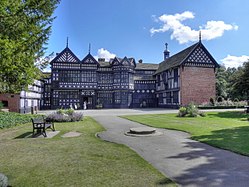| Bramall Hall | |
|---|---|
 Bramall Hall from the west, the side of the main entrance, showing the courtyard and the north and south wings. The Great Hall is in the centre. | |
| General information | |
| Architectural style | Tudor |
| Town or city | Bramhall, Greater Manchester |
| Country | England |
| Coordinates | 53°22′26″N 2°10′00″W / 53.3740°N 2.1666°W |
| Construction started | 14th century |
| Technical details | |
| Structural system | Timber framed |
| Website | |
| Bramall Hall – Stockport Council | |
Listed Building – Grade I | |
| Official name | Bramall Hall |
| Designated | 9 August 1966 |
| Reference no. | 1260476 |
Bramall Hall is a largely Tudor manor house in Bramhall, Greater Manchester, England. Its oldest parts date from the 14th century, with additions from the 16th and 19th centuries. It is a notable example of the timber-framed buildings found throughout the historic county of Cheshire. The house functions as a museum and its 70 acres (28 ha) of landscaped parkland (Bramhall Park) are open to the public.
The manor of Bramall was first described in the Domesday Book in 1086, when it was held by the Massey family. From the late 14th century, it was owned by the Davenports, who built the present house and remained lords of the manor for about 500 years. In 1877, they sold the estate of nearly 2,000 acres (810 ha) to the Manchester Freeholders' Company, a property company formed to exploit the estate's potential for residential building development. The hall and a residual park of over 50 acres (20 ha) was sold on by the Freeholders to the Nevill family of successful industrialists.
In 1925, it was purchased by John Henry Davies and then, in 1935, acquired by Hazel Grove and Bramhall Urban District Council. Following a local government reorganisation in 1974, Bramall Hall is now owned by Stockport Metropolitan Borough Council, which describes it as "the most prestigious and historically significant building in the Bramhall Park Conservation Area."[1]
